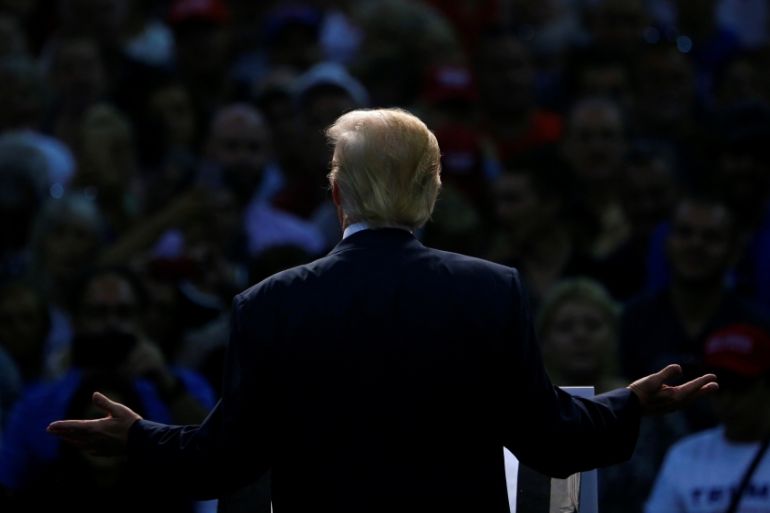How Donald Trump could win – and why
Old electoral alliances are cracking up, and the new have yet to clearly form.

Scarcely eight months ago, some influential Democrats were delighted by signs of Donald Trump’s success.
The strategy was clear. See off Bernie Sanders, veer right, target “moderate” Republicans and wait for the landslide.
Keep reading
list of 4 itemsFull jury panel seated on third day of Trump’s New York hush-money trial
Jacob Zuma’s nine lives: How South Africa’s ex-president keeps coming back
A flash flood and a quiet sale highlight India’s Sikkim’s hydro problems
The appointment of conservative Southern Democrat Tim Kaine, admired by Republicans, as her running mate reflects this emphasis. Reprising Lyndon Johnson’s famous anti-Barry Goldwater ad from 1964, Hillary Clinton seems to believe that Trump’s awfulness is enough to pave the way to power.
Obama’s crumbling coalition
In normal circumstances, this should work. Trump is behind on money and organisation. Major hedge-fund and business donors are backing Clinton, as are key figures in the Republican establishment.
Much of the right-wing media machine has turned against him. The electoral map does not favour him. Even though his projected popular vote is not that far behind Clinton’s, the geographical distribution of his vote means that the Electoral College system could play against him.
Clinton thus hopes to take over Barack Obama’s electoral coalition, while adding new layers of Republican voters to it. But what if this is all horribly complacent? What if Democrats and their supporters have misjudged the situation and are in for a rude awakening?
The legacy of the Obama administration means that his coalition is crumbling. The record of stagnant wages, shrinking government spending, and no real infrastructural investment is likely to affect Democratic performances in the rustbelt, which Trump is targeting.
While Trump may be hated for being a bigoted loose cannon, Clinton's weakness is precisely that she's seen as an untrustworthy and coddled establishment hack.
It is a cliche that Trump’s base is “the white working class” – in fact, he draws support from across classes, and the average income of his supporters in the Republican primaries is far higher than that for the population. Nonetheless, there is a big chunk of white workers who are supporting Trump.
And with the record number of the US Immigration and Customs Enforcement raids and the increase in police violence, coupled with Clinton’s record of support for mass incarceration and deportations – particularly younger blacks and Latinos – voters may not turn out in the numbers that Clinton needs.
Currently, even amid the Clinton bounce, Trump is competitive in swing states such as Florida, Ohio, Iowa, and even Pennsylvania, where a rise in racism and economic insecurity could give Trump a way in. All of these states went to Obama in 2012, yet they are within a fingernail’s reach of being taken by Trump.
No excitement for Hillary
Trump has thrived on the reproval of the political establishment and the media. The very bullying, blow-hard, racist and sexist provocations that have astonished the political class have tended to play to his advantage.
Consider the aftermath of his racist remarks about Mexicans. His “favourability” ratings improved, and he went on to destroy his opponents to win the Republican nomination against the predictions of leading pundits such as statistician Nate Silver, as well as the betting markets.
OPINION: Welcome to the Trump show
Even today, while Trump’s favourability ratings are poor, Clinton’s aren’t much better. While Trump may be hated for being a bigoted loose cannon, Clinton’s weakness is precisely that she’s seen as an untrustworthy and coddled establishment hack – something not helped by her propensity to opportunistically change her political line at the drop of a hat, her continual whiff of scandal, and the Democratic leadership’s extraordinary efforts to deny her rival, Bernie Sanders, the nomination.
As filmmaker and author Michael Moore put it, “No Democrat, and certainly no independent, is waking up on November 8 excited to run out and vote for Hillary.”
Trump has zeroed in on this, mocking “Crooked Hillary”. During the Democratic National Convention, Trump sent an attack ad to delegates’ mobile phones, accusing Clinton and the party machine of stealing the election, arguing that “Bernie never had a chance”.
Moving heaven and earth
And this isn’t the only way in which Trump is targeting the Democratic base. As a populist, Trump can defend “free markets” and welfare and protectionism at the same time.
He has criticised the Trans-Pacific Partnership, sided with environmentalists on fracking, proposed to double Clinton’s spending on national infrastructure, and defended Medicare and social security.
These positions, alongside his attack on the Iraq war, have scandalised the traditional right, but they will be attractive to some white Democrat voters.

The political centre from which Clinton seeks to govern has been contracting for eight years. Recession, bailouts, declining living standards and a ruined infrastructure have destroyed the old “free market” governing consensus.
Old electoral alliances are cracking up, and the new have yet to clearly form. A voting prediction model developed by political scientist Alan Abramowitz indicates that, were it not for Trump’s erratic messaging, these factors would be sufficient to give him a lead already.
This is Clinton’s problem. The centre-seeking strategy that once confirmed her husband in power, and led to NAFTA and the decimation of welfare, is no longer a winner.
When Democrats moved heaven and earth to stay rooted in an antiquated centre, the election became Trump’s to lose.
Richard Seymour is an author and broadcaster based in London. He has written for The Guardian, the London Review of Books and many other publications.
The views expressed in this article are the author’s own and do not necessarily reflect Al Jazeera’s editorial policy.
